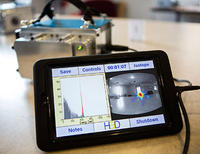-
Innovative nuclear radiation detector reaches the market

A handheld radiation camera developed by University of Michigan engineering researchers offers nuclear plant operators a faster way to find potentially dangerous hot spots and leaky fuel rods. The new Polaris-H detector lays a gamma-ray map over an image of a room, pinpointing radiation sources with unprecedented precision. At least four U.S. nuclear power plants are using versions of the camera, which is now available commercially through the U-M spinoff company H3D.
-
-
Underground recovery process at WIPP begins
Nuclear Waste Partnership (NWP), the management and operations contractor at the Waste Isolation Pilot Plant (WIPP) for the U.S. Department of Energy (DOE), said it has initiated the first phase of an underground recovery process which will lead to the resumption of nuclear waste disposal operations at WIPP. Initial results show no airborne radioactive contamination in the underground shafts.
-
-
Scotland demands U.K. govt. apology over radiation leak at MoD nuke facility
In 2012 the U.K. Ministry of Defense decided to refuel the nuclear reactor on board Britain’s oldest nuclear submarine, HMS Vanguard, after a test reactor operating at the Naval Reactor Test Establishment at Dounreay, Caithness, in Scotland was found to have a small internal leak of radiation. The test reactor had been shut down after the fault was detected, and both the independent Defense Nuclear Safety Regulator and the Scottish Environment Protection Agency (SEPA) had been informed. It now appears that SEPA did not share the information with the Scottish cabinet, or with Alex Salmond, the First Minister of Scotland. Salmond, in a scathing letter to British Prime Minister David Cameron, has demanded an apology from Camron for “disrespecting” the Scottish Parliament and the people of Scotland and for treating both in an “underhanded” manner by not sharing the information about the radiation leaks.
-
-
Determining long-term effects of West Virginia chemical spill
A chemical mixture called crude 4-methylcyclohexane methanol (MCHM) is used during the separation and cleaning of coal products. More than 10,000 gallons of the chemical leaked from a storage tank near Charleston, West Virginia, and entered the river upstream of a water-treatment plant on 9 January. The drinking water of more than 300,000 West Virginians was contaminated. Water restrictions began to be lifted on 13 January, but residents are still detecting the telltale odors of MCHM. Virginia Tech faculty engineers and students are unravelling fundamental chemical and health properties of MCHM.
-
-
New technique allows better monitoring of water quality
Researchers have developed a new technique that uses existing technology to allow researchers and natural resource managers to collect significantly more information on water quality to better inform policy decisions. In addition to its utility for natural resource managers, the technique will also allow researchers to develop more sophisticated models that address water quality questions.
-
-
Radiation problems on San Francisco’s Treasure Island persist

The Army Corps of Engineers created San Francisco’s Treasure Island for the 1939 Golden Gate International Exposition, with plans to turn the island into a civilian airport after the exposition. When the United States entered the Second World War in 1941, the Navy used the island for the Treasure Island Naval Station, where nuclear war training exercises were conducted. The Naval Station was decommissioned in 1993, and parts of the island were transferred to SF for civilian use. Radiation levels on the island are still high, however, and critics charge that the Navy did not do enough to clean the island while downplaying the risks of radiation that still remain.
-
-
Employees exposed to radiation at nuclear waste disposal site
Thirteen employees at the Waste Isolation Pilot Plant(WIPP),a nuclear waste burial site in New Mexico, have been exposed to radioactive radiation after a leak in one of WIPP’s underground tunnels. Energy Department officials say it is too soon to determine the scope of health risks the employees will deal with. The employees inhaled plutonium and americium, both of which can irradiate the body’s internal organs with subatomic particles for a lifetime.
-
-
Islanders’ radiation worries 60 years after Bikini Atoll atomic test

Sixty years ago, On 1 March 1954 the United States tested a 15-megaton hydrogen bomb – a thousand times more powerful than the bomb dropped on Hsroshima —- at Bikini Atoll, part of the Marshall Islands. The explosion vaporized one island, and exposed inhabitants on neighboring islands to radioactive fallout. The United States relocated many of the islanders and spent years – and more than $45 million – to clean up and decontaminate the islands, before allowing the relocated inhabitants to return. Many were forced to leave again, however, after they were found to be exposed to residual radiation. From 30 June 1946 to 18 August 1958, the United States conducted 67 atmospheric nuclear tests in the Marshall Islands.
-
-
Operator of Hanford nuclear disposal site fires scientists who voice safety concerns
The Hanford project in Washington State is the Department of Energy’s (DoE) largest nuclear cleanup project. DoE plans to transform fifty-six million gallons of radioactive sludge, currently stored in underground tanks, into solid glass. Scientists and engineers who work at Hanford have questioned the effectiveness of the required technology, and have voiced serious concerns about safety issues. Two of those who were the most persistent in voicing their concerns about safety have been fired, and a third one has left his job voluntarily.
-
-
Faster anthrax detection could speed bioterror response
The fall 2011 anthrax attacks cost $3.2 million in cleanup and decontamination. At the time, no testing system was in place that officials could use to screen the letters. Currently, first responders have tests that can provide a screen for dangerous materials in about 24-48 hours. Now, researchers have developed a new method for anthrax detection that can identify anthrax in only a few hours.
-
-
Positive safety results Marburg drug candidate announced
Marburg hemorrhagic fever is a severe and potentially fatal disease in humans first recognized in 1967. It is caused by an RNA virus of the Filoviridae family and is understood to be endemic to Africa. The Marburg virus is classified as a Category A bioterrorism agent by the Centers for Disease Control and Prevention (CDC), and in 2006 was determined by DHS to be a material threat to national security and public health. There are currently no treatments for Marburg virus infection beyond supportive care. Cambridge, Massachusetts-based Sarepta Therapeutics, a developer of innovative RNA-based therapeutics, announced positive safety results from a Phase I multiple ascending dose study of AVI-7288 in healthy volunteers. AVI-7288 is the company’s lead drug candidate for the treatment of Marburg virus infection.
-
-
Exposure to IED blasts increases risk of long-term health consequences
Blasts are the leading cause of death and injury on the battlefield, accounting for about 75 percent of all combat-related injuries in U.S. military personnel. U.S. soldiers exposed to blasts while deployed in Iraq and Afghanistan have an increased risk of developing adverse health outcomes over the long term, such as post-traumatic stress disorder (PTSD) and, in certain cases of traumatic brain injury (TBI), growth hormone deficiency, and persistent post-concussive symptoms including headaches, says a new report.
-
-
25 children in California stricken with polio-like illness
Twenty-five children in California have been exhibiting a “polio-like syndrome,” leading to paralysis in one or more of their limbs. “What’s we’re seeing now is bad. The best-case scenario is complete loss of one limb, the worst is all four limbs, with respiratory insufficiency, as well. It’s like the old polio,” say a a pediatric neurologist. Scientists say that samples from two of the children tested positive for enterovirus 68, a rare virus linked in the past to severe respiratory illness.
-
-
Improving livestock diets to bolster food security, combat climate change
Livestock production is responsible for 12 percent of human-related greenhouse gas emissions, primarily coming from land use change and deforestation caused by expansion of agriculture, as well as methane released by the animals themselves, with a lesser amount coming from manure management and feed production. A new study shows that within the current systems, farmers would find it more profitable in coming years to expand livestock production in mixed systems — where livestock are fed on both grass as well as higher quality feed — rather than in pure grass-based systems. This development, would lead to a 23 percent reduction of emissions from land use change in the next two decades without any explicit climate mitigation policy.
-
-
Not much is known about long-term health effects of chemical leaked in W.Va.
In January, 10,000 gallons an obscure chemical called 4-methylcyclohexanemethanol, or MCHM, used in processing coal, leaked from storage tanks into the nearby Elk River in the Charleston, West Virginia area, contaminating the water of more than 300,000 residents for days. To what degree MCHM affects long-term human and fetal health is a major concern for residents because of the lack of complete toxicology and other studies on the chemical.
-
More headlines
The long view
We Ran the C.D.C.: Kennedy Is Endangering Every American’s Health
Nine former leaders of the Centers for Disease Control and Prevention (CDC), who served as directors or acting directors under Republican and Democratic administrations, serving under presidents from Jimmy Carter to Donald Trrump, argue that HHS Secretary Roert F. Kennedy Jr. poses a clear and present danger to the health of Americans. He has placed anti-vaxxers and conspiracy theorists at top HHS positions, and he appears to be guided by a hostility to science and a belief in bizarre, unscientific approaches to public health.
